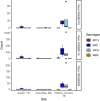Local adaptation of both plant and pathogen: an arms-race compromise in switchgrass rust
- PMID: 40545777
- PMCID: PMC12489299
- DOI: 10.1111/nph.70313
Local adaptation of both plant and pathogen: an arms-race compromise in switchgrass rust
Abstract
In coevolving species, parasites locally adapt to host populations as hosts locally adapt to resist parasites. Parasites often outpace host local adaptation since they have rapid life cycles, but host diversity, the strength of selection, and external environmental influence can result in complex outcomes. To better understand local adaptation in host-parasite systems, we examined locally adapted switchgrass (Panicum virgatum), and its leaf rust pathogen (Puccinia novopanici) across a latitudinal range in North America. We grew switchgrass genotypes in 10 replicated multiyear common gardens, measuring rust severity from natural infection in a 'host reciprocal transplant' framework for testing local adaptation. We conducted genome-wide association mapping to identify genetic loci associated with rust severity. Genetically differentiated rust populations were locally adapted to northern and southern switchgrass, despite host local adaptation to environmental conditions in the same regions. Rust resistance was polygenic, and distinct loci were associated with rust severity in the north and south. We narrowed a previously identified large-effect quantitative trait locus for rust severity to a candidate YELLOW STRIPE-LIKE gene and linked numerous other loci to defense-related genes. Overall, our results suggest that both hosts and parasites can be simultaneously locally adapted, especially when parasites impose less selection than other environmental factors.
Keywords: BLUP; GWAS; biofuel; coevolution; fungal disease; microbial ecology; rust; switchgrass.
© 2025 The Author(s). New Phytologist © 2025 New Phytologist Foundation.
Conflict of interest statement
None declared.
Figures







References
-
- Aktar‐Uz‐Zaman M, Tuhina‐Khatun M, Hanafi MM, Sahebi M. 2017. Genetic analysis of rust resistance genes in global wheat cultivars: an overview. Biotechnology & Biotechnological Equipment 31: 431–445.
-
- Asnaghi C, D'Hont A, Glaszmann JC, Rott P. 2001. Resistance of sugarcane cultivar R 570 to Puccinia melanocephala isolates from different geographic locations. Plant Disease 85: 282–286. - PubMed
MeSH terms
Grants and funding
LinkOut - more resources
Full Text Sources

